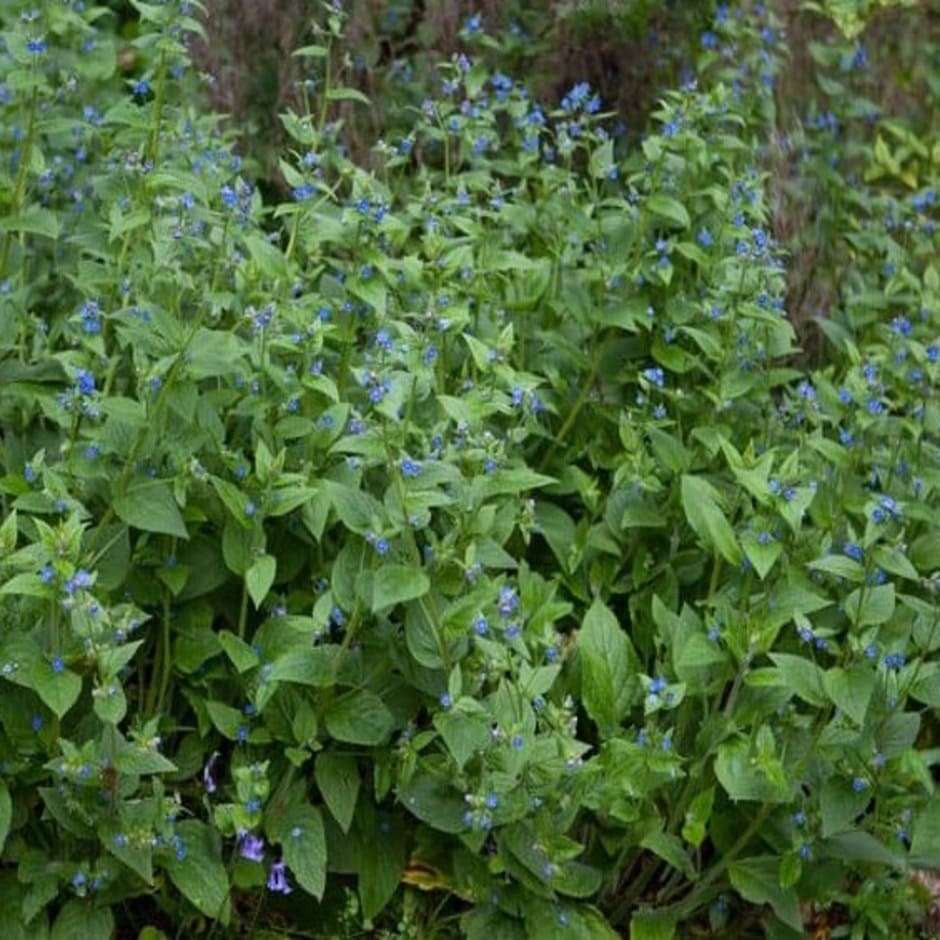Green alkanet
Gardeners and pollinators love the vivid blue flowers of green alkanet. It provides good ground cover in shady areas, but its large, coarse leaves and tendency to spread might make it unwelcome in some parts of the garden.

Quick facts
- Green alkanet’s botanical name is Pentaglottis sempervirens
- It is sometimes mistaken for other plants in the borage family (Boraginaceae), such as comfrey, forget-me-not and Brunnera
- Green alkanet is a long-lived perennial with a deep taproot
- The flowers are edible and make a pretty garnish on salads and desserts
- Green alkanet’s nectar-rich flowers are visited by bees, hoverflies and butterflies
- If you need to control green alkanet, non-chemical methods are effective
Jump to
What does green alkanet look like?
Green alkanet forms a rosette of bristly, pointed, oval leaves up to 40cm (16in) long. Sometimes the leaves have small white speckles.
Upright, bristly stems bear smaller leaves and start to produce pinkish-mauve flower buds in spring. The buds open to small, bright blue flowers with white centres. Flowering continues through summer if the ground is moist.
In its preferred growing conditions of partial shade and damp soil, green alkanet grows to about 90cm (3ft) tall.
Is green alkanet a weed?
When first introduced into Britain over 300 years ago, green alkanet was valued as an ornamental plant. Few nurseries sell it now, but as a garden escapee it is commonly seen in shady hedgerows and on roadside verges, particularly in the south of England.
Its nectar-rich flowers are attractive to pollinators, including bees, hoverflies and butterflies, and its leaves are food for the larvae of the exotic-looking scarlet tiger moth. They also form dense ground cover, providing habitat and shelter for various creatures including ground-active invertebrates.
However, green alkanet is a vigorous perennial that can smother smaller plants, so it may not be welcome in some areas of your garden. It also self-seeds readily, so can quickly spread out of bounds.
Frequently asked questions about controlling green alkanet
Here are our answers to your most common questions about dealing with green alkanet:
How invasive is green alkanet?
Individual plants do not tend to spread very far, but as green alkanet produces seed, and its seedlings generally arise close to the parent plant, a single plant can quickly become a patch. The seed can also be transported over some distance on animal fur or by humans, so it can pop up in other parts of the garden too. Gardeners may also unintentionally spread green alkanet by distributing small sections of root which can grow into new plants.
The good news is that it is possible to enjoy green alkanet in your garden and control its spread, by deadheading plants before they set seed, removing seedlings in unwanted locations, and taking care not to add roots to your home compost bin or spread them when moving soil or sharing plants.
Do I need to get rid of green alkanet?
No - allowing some green alkanet to grow in shady areas, at the back of borders or under established hedges or trees, is a great way to attract wildlife and increase the biodiversity of your garden.
Green alkanet is a useful ground cover plant. If cut down to ground level soon after flowering in spring, it will produce fresh leaves that look good into autumn, and won’t be able to self-seed.
What is the easiest way to kill green alkanet?
If you have green alkanet growing where it is not wanted, there are methods of controlling it:
- Pull or fork out seedlings - pull out new seedlings if you have loose soil, otherwise use a hand fork to ensure you remove all the roots – plants start developing a taproot when young. Keep a look out for emerging seedlings near existing clumps of green alkanet.
- Dig out plants - use a border fork or spade to dig out clumps, aiming to get as much of the root system out as possible. Hand tools designed for deep-rooted weeds, often sold as ‘dandelion weeders’, are useful for targeting taproots and limiting soil disturbance. Check the area afterwards and keep removing any new growth that appears – this will weaken and eventually eradicate the plant.
- Smother plants – cut off the leaves and cover the ground with cardboard and a 20cm (8in) thick layer of organic matter, such as bark or wood chips. Alternatively, use a heavy grade biodegradable mulch matting. This will block light and prevent growth, causing the root system to die. Keep soil covered for a few years to ensure this method is effective.
Should I use weedkiller?
No – as non-chemical control methods are effective, there is no need to use a weedkiller.
Get involved
The Royal Horticultural Society is the UK’s leading gardening charity. We aim to enrich everyone’s life through plants, and make the UK a greener and more beautiful place.